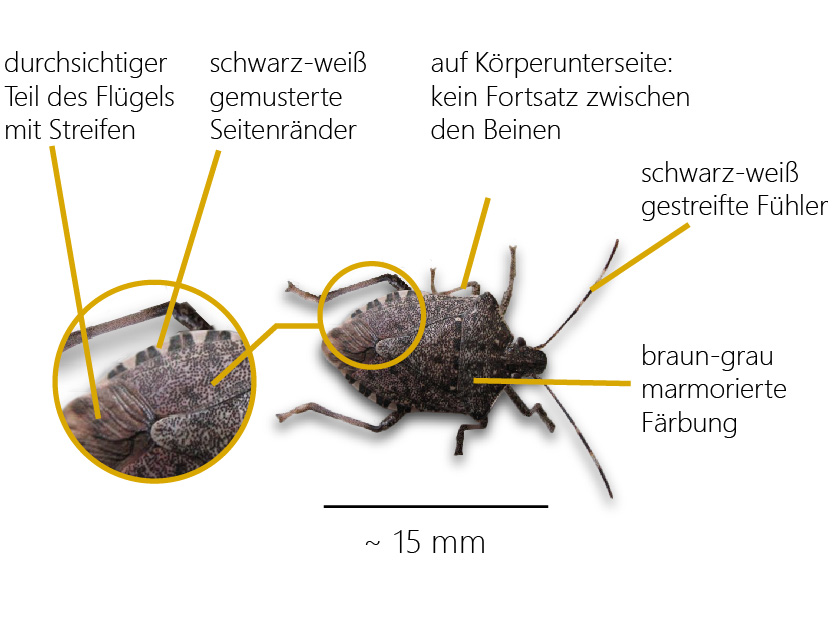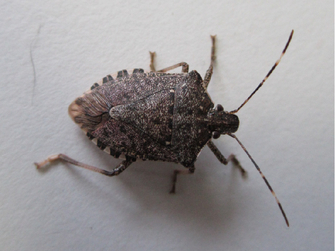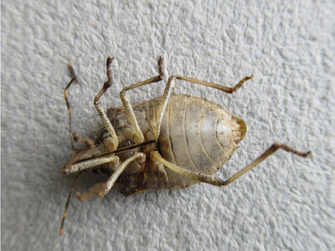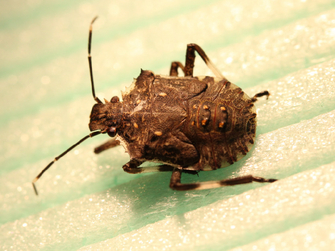Brown marmorated stink bug
Halyomorpha halys
Appearance
The brown marmorated stink bug belongs to the family of tree bugs (Pentatomidae). It is about 15 mm in size, brown-gray marbled in color with conspicuous black and white patterned lateral margins on the abdomen and with black and white striped antennae. There is no appendage between the legs on the underside of the body.





Possibilities of confusion
Confusion with native species is possible, e.g. with the following species:
- Berry bug(Dolycoris baccarum)
- Holcostethus (= Peribalus) strictus
- Gray garden bug(Rhaphigaster nebulosa)
However, the marbled tree bug can be clearly distinguished from the gray garden bug by some characteristics (e.g. no elongated process on the underside of the body between the legs, bright spots behind the neck shield, stripes in the transparent part of the wings).
Biology
The adult bugs become active in spring at temperatures above 10 °C and search for suitable host plants, where they feed on plant sap. After several weeks of sucking activity, the females begin laying eggs, which continues into late summer. Their egg clutches (groups of 20 to 30 eggs) are located on the underside of leaves, and a female can lay an average of more than 200 eggs, with a maximum of about 450 eggs. After only a few days, the larvae (nymphs) hatch and like to stay in groups on the plants. After five nymphal stages, they molt into adult bugs. The development from egg to adult bug takes about one and a half to two months. The bugs suck mainly on fruits, but also on leaves. In the fall they leave their host plants and look for overwintering quarters, where they like to gather in larger numbers in sunny places, such as house facades and windows, where they can become a nuisance to humans, but completely harmless. They overwinter as adults in protected areas, such as garden sheds and houses.
In their original habitat (Asia), five to six generations develop per year; in Europe, only one to two generations (in warmer areas) are expected.
Damage symptoms
The marbled tree bugs sting leaves and fruits with their proboscis to suck the plant sap. In the process, a protein (enzyme) enters the plant tissue with the saliva, causing stains and necroses, which can later discolor and deform the fruit. Not only do the fruits become unsightly and no longer marketable, but the infested plant parts may also die or fall off prematurely.
These symptoms are often not clearly attributable to the marmorated tree bug, because other sucking insects, e.g. soft bugs (Miridae), cause similar damage.
Host plants
The marbled tree bug is a very polyphagous species of bug that can use more than 100 different plant species as host plants. Mainly it sucks on fruit crops, but also on ornamental trees and shrubs as well as forest trees, plants of vegetable and arable crops and herbaceous plants. It prefers species of the rose family (Rosaceae), such as apple, pear, cherry, peach, nectarine, raspberry, and citrus. Common host plants are also found among ornamental shrubs, such as summer lilac(Buddleia davidii), bluebell tree(Paulownia tomentosa), and trumpet tree(Catalpa bignonioides). Peppers and tomatoes are among the preferred host plants among vegetable crops.
Distribution
The original natural distribution of the brown marmorated stink bug is in eastern Asia (eastern China, Taiwan, Korea, Japan). From there it was probably introduced with transport crates to North America in 2001, but was probably already present since 1996, and then spread very rapidly and massively. In Europe, it was first detected in Liechtenstein (2004) and then in Switzerland (2007); it is now already found in many European countries. In Austria, the first specimens of the brown marmorated stink bug were discovered in Vienna and in Dornbirn (Vorarlberg) in 2015; since autumn 2016, the brown marmorated stink bug was frequently seen on and in houses in Vienna, where it was looking for overwintering sites.
Prevention and control
International studies and experience in controlling the marmorated stink bug, e.g. with different types of traps, "attract & kill" methods and also mechanical barriers (e.g. netting, sticky bands around the tree trunks) and broad-spectrum plant protection products, have so far only shown partial control success. For Austria, plant protection products for controlling the marmorated stink bug or stink bugs in general can be found in the list of plant protection products authorised in Austria.
In China, there are several species of chalcid wasps (Chalcidoidea) that parasitise the eggs of Halyomorpha halys. Representatives of Trissolcus spp. and Anastatus spp. can achieve very high parasitisation rates (up to 85 %). Various research projects are currently underway on the influence of native natural antagonists (parasitoids, predatory insects and spiders) in Europe against the marmorated stink bug and the potential use of non-native chalcid wasps for biological pest control.
Specialized information
Suspected cases
If suspicious bugs are found (similar in appearance to brown marmorated stink bug), they can be sent to us for clarification of species or identification, but prior contact is encouraged.
Research
We conduct ongoing surveys on the occurrence of various introduced organisms. Within the framework of the international EUPHRESCO project EPIDISARTH, which started in 2021, the distribution of the brown marmorated stink bug in Austria is surveyed.
Publications
Lethmayer, C., 2017. halyomorpha halys - spread in Austria. Better Fruit 12(6).
Last updated: 10.04.2025
automatically translated